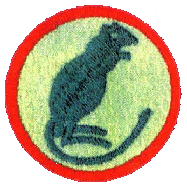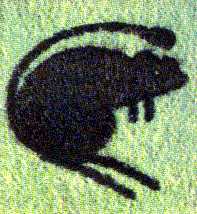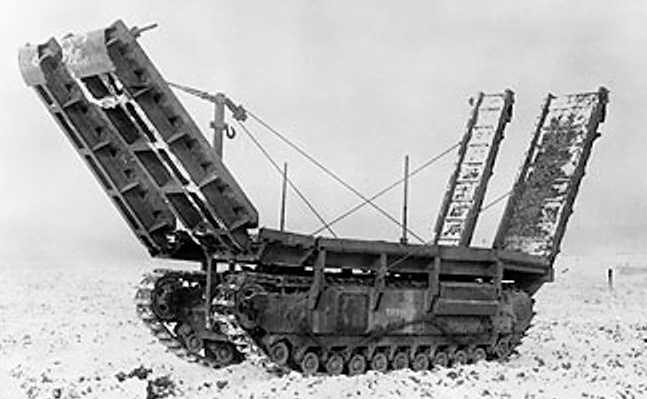

Equipment Used By the Armoured Brigades
During the war both 4th and 7th Armoured used many
different weapons and vehicles. The majority of the equipment used is the same
as that used by 7th Armoured Division and so as to avoid unnecessary duplication
please go to the 7th
Armoured Division Equipment Page ![]() to find out more information.
to find out more information.
This page provided details of equipment used by either of the two Brigades that was not used by 7th Armoured Division. It also provided links the equipment used by the different types of units.
Tanks
For Valentine, Stuart and Sherman Tanks please go to the 7th
Armoured Division Tanks Equipment Page.
![]()
After the British Expeditionary Force had been evacuated at Dunkirk, having lost most of their equipment in the process, the British Army was in dire need of replacements. This was especially so for Tanks, of which there were only about 100 in the British Isles at that time. To accommodate this, the British government pushed forward a tank design that predated the onset of the Second World War, the A20.
Th A20 was designed to meet the expected needs of First World War style trench warfare, where the main emphasis of the tank was to navigate shell cratered ground and demolish infantry obstacles such as barbed wire and was influenced that for the French Char B tank. Between then the Woolwich Arsenal and Harland & Wolff developed the A20 from a specification in 1939 to working prototype form by June 1940. Once had been complete Vauxhall (the car manufacturers) took over the project, designing and building a prototype, which was designed the A22 by November 1940. The later version of tank had evolved based on the battles in Poland and France. However it still kept many of the same features that would put it a disadvantage confronted with the rapid nature of blitzkrieg tactics but were also prove to be some of its strengths. The first production units were available by the middle 1941.
The hull was made up of simple flat plates initially bolted but later welded together. The suspension was fitted under the two large "panniers" either side of the hull - the track running over the top. There were 11 bogies either side, each carrying two 10-inch wheels. Only 9 of the bogies were taking the vehicle weight normally, with the front ones only coming into play when the vehicle nosed into the ground or against an obstacle. The rear ones acted in part as track tensioners. The twin engines were connected through a common crankshaft feeding a regenerative transmission steered by a tiller bar rather than levers or steering wheel. The interior was comparatively roomy and the large hatches in the sides made escape easy. They were also to be one of the reasons for its later conversion into the AVRE. The first turrets were cast with a rounded shape - sufficient for the relatively small 2-pdr gun, but when a larger gun (6-pdr) was required the turrets became larger with welded construction. To fulfil its role as an infantry support vehicle the first models were equipped with a 3 inch howitzer in the hull and although this could deliver a useful HE round complementing the weakness of the 2-pdr in that area it was limited by a poor fire arc, due to the way the tracks extended in front of the hull.
The hurried production in light of a possible invasion and lack of field tests, meant that the tank entered service while still suffering from mechanical problems and defects. This meant that it performed poorly in its first combat outing, which was the disastrous raid on Dieppe in 1942. After numerous modifications, the tank did begin to see better performance in the North African Campaign though, where its exceptionally heavy armour, low silhouette and good climbing abilities gave it a reasonable degree of success. However, main complaints against it were that is was very low speed and had poor armament. These two weaknesses that would haunt it throughout its entire career, but after some modifications the Churchill tank served later in both the Italian Campaign and the Western Front.
The Churchill had many variations, including many specialised modifications. This durability, which is really on a par with the US Sherman, Soviet T-34 or the German Panzer IV, is a sign of a successful tank model. The most significant change to the Churchill was that it was up gunned from 2-pdr to 6-pdr and then 75 mm guns over the course of the War. By the war's end, some late model Churchills had exceptional amounts of armour, which was considerably more than the German Tiger tank. Below is a list of the variant of the tank
Churchill I (303 produced) - Equipped with a 2-pdr gun in the turret, and both a coaxial BESA machine gun and a 3 inch howitzer in the hull. This variant tank was noted for poor mechanical reliability and was the main tank issued to the Canadian forces at Dieppe.
Churchill II (1,127 produced) - The hull howitzer was replaced by another machine gun to reduce cost and complexity. This is sometimes referred to as Churchill Ia.
Churchill IICS (Close Support) - In this version the 2-pdr was fitted in the hull and the howitzer in the turret. It produces in very limited numbers and is sometimes called Churchill II.
Churchill III (675 produced) - The MK III was the first major armament overhaul of the series, eliminating the hull howitzer and equipping the tank with a more powerful 6-pdr gun, in a welded turret. Production started in March 1942.
Churchill IV (1,622 produced) - The MK IV was the most numerous Churchill produced, and was virtually identical to the MK III, with the largest change being a return to the less costly cast turret.
Churchill V (241 produced) - A Churchill III / IV which was equipped with a 95mm howitzer in place of the main gun, to produce a Close Support variant.
Churchill VI (200 produced) - This incorporated with several minor improvements and it was produced standard with the 75mm Mk V gun. Few were built due to the near release of the MK VII and current up gunning of existing MK III and MK IV.
Churchill VII (1,600 produced along with MK XIII, below) - This was the second major redesign from previous models and it used the 75 mm gun, with wider tracks and had much more armour. A commanders cupola (shown right) similar to those fitted to German tanks was also fitted, which allowed visibility from the turret without the need to be outside the hatch. It is sometimes called the Heavy Churchill and first saw service in the Battle of Normandy, and was redesignated A42 in 1945.
Churchill VIII - This was Churchill VII with replaced the main gun with a 95mm howitzer, to produce a Close Support variant.
Churchill IX - This was Churchill MK III or MK IV which was upgraded with turret of the MK VII. Extra armour added along with gearbox and suspension modifications. In some cases the old 6-pdr was retained and then the tanks would have the additional designation of LT ("light").
Churchill X - The same improvements as for the MK IX applied to a MK VI.
Churchill XI - This was a Churchill MK V with extra armour and MK VIII turret.
Churchill OKE - This was a Churchill MK II in which one of the hull machine guns exchanged for a flamethrower. There were three present at Dieppe which were quickly hit, and abandoned.
Churchill 75 mm (84 produced) - This was a battlefield modification to a Churchill MK III or MK IV which used the existing turret fitted with the mantlet and 75mm gun from a destroyed or scrapped Sherman (known as NA 75 from North Africa where the conversions took place). Alternatively some had their existing gun re-bored to 75 mm and these were otherwise known as the MK III* or MK IV (75mm). More MK IV's were modified than MK III's, and their performance is virtually identical to the MK VI.
Churchill AVRE (Armoured Vehicle Royal Engineers) - This was a Churchill MK III or MK IV equipped with a 290 mm Spigot (Petard) mortar, throwing the 40 pound (18 kg) "Flying dustbin" with its 28 pound high explosive warhead. The weapon was designed for the quick levelling of fortifications, after the Canadian failures at Dieppe. The basic tank could also be equipped with numerous other attachments, such as mine flails, fascine rollers, explosive placers, etc.
 Churchill ARK - This was a turretless Churchill with ramps at either end and along the
body to form a mobile bridge. The Mark 1 ARK had 2' wide trackways over the tracks for
vehicles to drive along and the vehicle would lower ramps by a quick release,
while the Mark 2 ARK was an improvised version and crossing
vehicles drove directly on the Churchill's tracks. There were two versions of
the Mark 2, with one the 'UK Pattern' having wider trackways than the ARK MK 1
which were now 4ft wide and the 'Italian Pattern' which was the 'UK Pattern'
tank, but used US ramps which were either 12' 3.5" (MK 2) or 15' 1"
(MK 1) wide. These had no built-up trackways, with the vehicles tracks being
used and these were produced by converting MK IIIs in Italy.
Churchill ARK - This was a turretless Churchill with ramps at either end and along the
body to form a mobile bridge. The Mark 1 ARK had 2' wide trackways over the tracks for
vehicles to drive along and the vehicle would lower ramps by a quick release,
while the Mark 2 ARK was an improvised version and crossing
vehicles drove directly on the Churchill's tracks. There were two versions of
the Mark 2, with one the 'UK Pattern' having wider trackways than the ARK MK 1
which were now 4ft wide and the 'Italian Pattern' which was the 'UK Pattern'
tank, but used US ramps which were either 12' 3.5" (MK 2) or 15' 1"
(MK 1) wide. These had no built-up trackways, with the vehicles tracks being
used and these were produced by converting MK IIIs in Italy.
 Churchill ARV (Armoured Recovery Vehicle) MK I - This was a turretless
MK I with a jib, while the ARV Mk II had a fixed turret/superstructure with a dummy gun. It
was equipped for recovering other tanks from the battlefield and mounted a front
jib with a 7.5 ton capacity, a rear jib rated for 15 ton and winch that could pull
25 ton. There was a crew of three, with enough room inside for the crew of the tank being recovered.
Armament was single BESA
machine gun or sometimes twin Bren guns for anti-aircraft defence.
Churchill ARV (Armoured Recovery Vehicle) MK I - This was a turretless
MK I with a jib, while the ARV Mk II had a fixed turret/superstructure with a dummy gun. It
was equipped for recovering other tanks from the battlefield and mounted a front
jib with a 7.5 ton capacity, a rear jib rated for 15 ton and winch that could pull
25 ton. There was a crew of three, with enough room inside for the crew of the tank being recovered.
Armament was single BESA
machine gun or sometimes twin Bren guns for anti-aircraft defence.
Churchill Crocodile (800 produced ) - This was one of the more notable Churchills and was a Churchill VII with the hull machine gun replaced with a flamethrower. The fuel was in an armoured wheeled trailer towed behind. It could fire several one second bursts over 150 yards. The 'Crocodile' was one of 'Hobart's Funnies' which served in 79th Armoured Division in Northern Europe.
Churchill 3-inch Gun Carrier (50 produced) - This has a fixed superstructure with the gun in a ball mount.
Churchill Flail FV3902 or Toad - This was a post-war (1950s) mine-clearing flail tank built on a Churchill chassis.
There several kinds of mine ploughs fitted to Churchills which were designed to either clear the path of the tanks tracks only or a sufficiently wide path for other vehicles to use. Besides these, the Churchill was used to develop and test many other obstacle clearing devices and contraptions.
Churchill , Specification:
|
Armament |
Armour |
Weight |
Length (m/ft in) |
Width (m/ft in) |
Height (m/ft in) |
Powerplant |
Speed (Km/h/Mph) |
Crew |
|
MK I & II: 1 x 2-pdr with Co-axial 7.92mm BESA MG plus 1 x 3-in Howitzer in hull |
102 mm Max |
38.5 tonnes |
7.3/ 24 ft 5 in | 3/ 8 ft 2 in |
2.8/ 8 ft 2 in |
MK III Bedford water cooled, 325 hp @ 2,200 rpm, Petrol MK IV 2 × Bedford 350 hp @ 2,200 rpm, Petrol |
26.5 / 16.5 road 15 / 8 off-road (Range of 192 km or 120 miles) |
5 |
|
MK III and IV: 1 x 6-pdr
with Co-axial 7.92mm BESA MG,
plus 1 x 7.92mm BESA MG in
hull
MK V with 3" Howitzer for CS version |
102 mm Max |
38.5 tonnes |
7.3/ 24 ft 5 in | 3.33/ 11 ft 4 in |
2.8/ 8 ft 2 in |
2× Bedford 350 hp @ 2,200 rpm, Petrol |
24 / 15 road 15 / 8 off-road (Range of 144 km or 90 miles) |
5 |
|
MK VI and VII: As above but with 75mm gun
MK VIII: with 95mm Howitzer for CS version |
152 mm Max |
38.5 tonnes |
7.3/ 24 ft 5 in | 3.33/ 11 ft 4 in |
2.8/ 8 ft 2 in |
2× Bedford 350 hp @ 2,200 rpm, Petrol |
21.7 / 12.5 road 15 / 8 off-road |
5 |
| Churchill Infantry Tank | |
| Wartime Film | Crocodile Version at Bovington |
| Crocodile at Bovington | Short Film Crocodile version |
Armoured Cars
For information on any Scout or Armoured Cars, please go to the
7th
Armoured Division Armoured Cars Equipment Page.
![]()
Artillery
For information on any Artillery (Field,
Self-Propelled, Anti-Aircraft or Anti-Tank) pieces, please go to the 7th
Armoured Division Artillery Equipment Page.
![]()
Infantry
For information on any equipment used by the
Infantry units in the Brigades, please go to the 7th
Armoured Division Artillery Equipment Page.
![]()
Others (including Royal Engineers, REME, Royal Signals)
For information on any equipment used by the
Infantry units in the Brigades, please go to the 7th
Armoured Division Other Equipment Page.
![]()
Back 7th Armoured Divisional Equipment Page